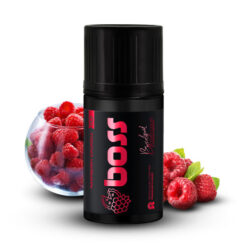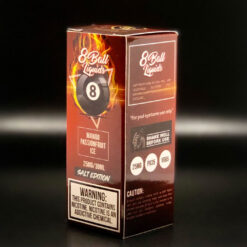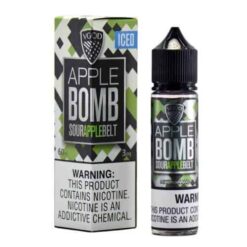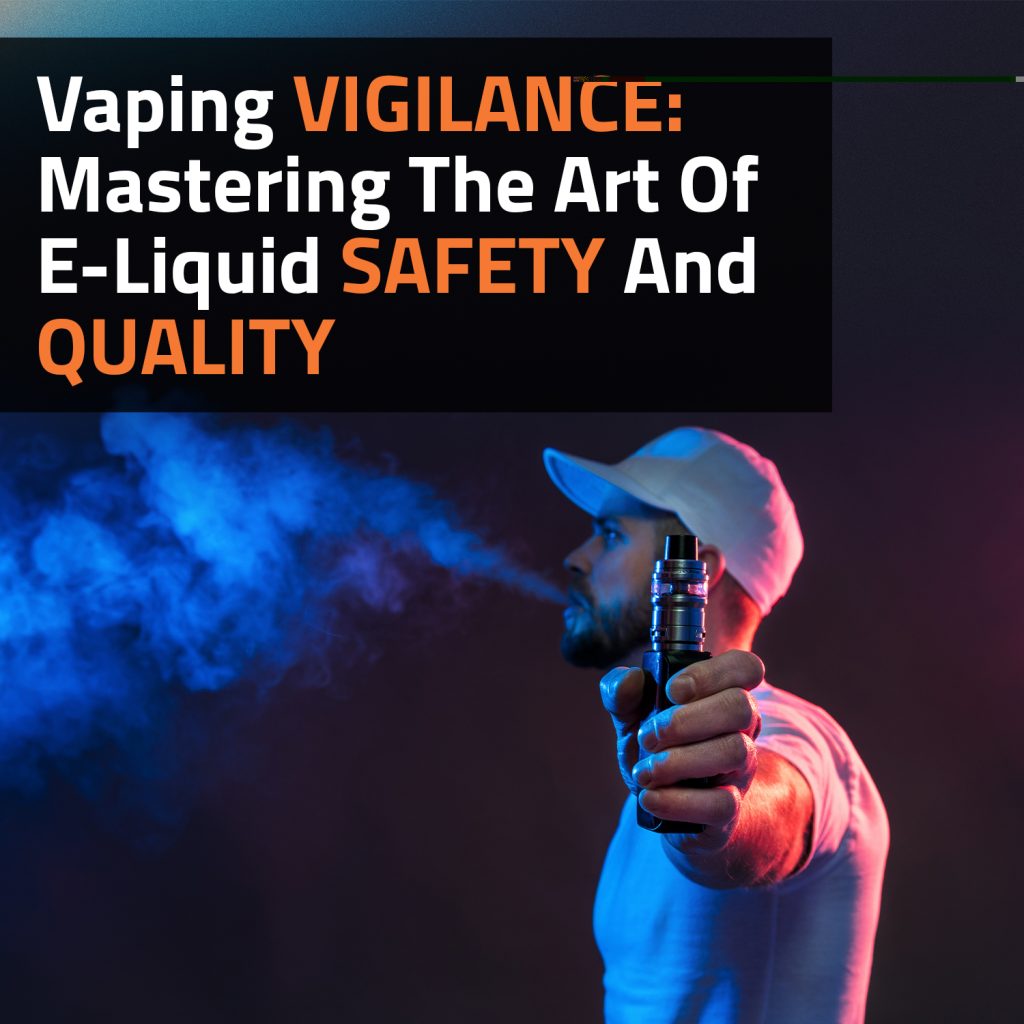In the dynamic landscape of vaping, understanding the nuances of e-liquids is paramount. As the heart of the vaping experience, e-liquids shape our sensory journey and have direct implications on our health. With the vaping industry evolving rapidly, there’s a pressing need to remain updated on ingredient integrity, potential health impacts, and best practices.
What Are E-Liquids?
E-liquids, commonly known as vape juices or e-liquids, form the core of the vaping experience. They are the fluids used in vaporisers and electronic cigarettes that get transformed into vapour. The ingredients of e-liquids are crucial not only for flavour but also for safety.
E-liquids are designed to deliver nicotine and flavour to the user when vaporised. They serve as a replacement for traditional tobacco in the form of a liquid. By offering various nicotine strengths and flavours, they cater to a wide range of preferences.
-
Boss E-Liquids – Raspberry Crumble
R260.00 -
8 Ball Liquids Saltnic – Mango Passionfruit Ice
R350.00 -
Brutal CBD – Black Currant
R195.00 – R380.00 -
VGOD – Apple Bomb Iced
R320.00
How Have E-Liquids Evolved Over The Years?
The journey of e-liquids is based on innovation, driven by consumer demand and technological advancements.
- Flavour Variety: In the early days of vaping, choices were limited. Vapers often had to make do with generic tobacco or menthol flavours. Fast forward to today, and we’re spoiled for choice! From the tang of exotic fruits to the sweet allure of desserts and the comforting warmth of beverages, there’s a flavour for every palate.
- Nicotine Options: The evolution didn’t stop at flavours. The introduction of “nic salts” revolutionised the nicotine landscape. While traditional freebase nicotine can sometimes be harsh on the throat at higher strengths, nic salts provide a smoother hit, allowing vapers to enjoy higher nicotine levels without the associated throat irritation.
What Are The Main Components In A Typical E-Liquid?
Venturing into the world of vaping means diving deep into the e-liquids’ composition. These concoctions are a blend of art and science. But what exactly goes into that little bottle?
- PG and VG: The backbone of every e-liquid. Propylene Glycol (PG) and Vegetable Glycerin (VG) set the stage. While PG carries flavours brilliantly and offers a distinct throat hit, VG is all about dense, billowing clouds of vapour and a slightly sweet taste.
- Flavourings: It’s these that transform the vaping experience, adding depth and character to every puff. Whether you’re reminiscing with a tobacco flavour, seeking refreshment with a minty burst, or indulging in a dessert delight, it’s the flavourings that make it possible.
- Nicotine: The force behind the ‘hit’ many vapers seek. Whether in its traditional freebase form or the newer, smoother nic salts, nicotine is what makes vaping a compelling alternative for many smokers.
- Additives: Not all e-liquids have them, but some might include a dash of something extra to enhance the overall experience – a pinch of sweetener, perhaps, or a touch of cooling agent for that icy finish.
Why Should We Understand E-Liquid Ingredients?
Imagine going to a restaurant and ordering a dish without knowing its ingredients. You’d be taking a gamble! The same logic applies to vaping. Knowing what you’re inhaling is paramount for a safe and enjoyable experience.
- Ingredients and Vaping Safety: It’s not just about flavour. The quality and makeup of e-liquid ingredients have direct implications for safety. Premium e-liquids prioritise high-grade components, minimising the risk of contaminants. Moreover, it’s essential to balance ingredient concentrations – even the finest ingredients can be harmful in excess.
- E-Liquid Ingredients and Health: Your body’s response to various e-liquid ingredients can vary. For instance, while PG and VG are generally recognised as safe, some vapers might experience an allergic reaction to PG. Nicotine, while satisfying for many, can be toxic in high doses.
- Spotlight on Controversial Ingredients: As with many emerging industries, vaping has seen its share of controversies. Ingredients like diacetyl, once beloved for its buttery flavour profile, have been linked to respiratory conditions. Likewise, Vitamin E acetate, safe for skin application and ingestion, became notorious for its association with vaping-related lung injuries. It’s always essential to be informed and make e-liquid choices based on the latest, most credible research.
What Are The Controversies Surrounding E-Liquid Ingredients?
In the dynamic world of vaping, not all e-liquid ingredients have been greeted with unanimous applause. Some have stirred debates, leading to research and reassessments.
How Does Vitamin E Acetate Impact E-Liquid Safety?
A lesson in how something beneficial in one form can be harmful in another. Vitamin E acetate, beneficial in skincare and dietary supplements, became a cause for concern for vapers.
- The Risks Involved: When vapers inhaled e-liquids containing this compound, it was linked to serious respiratory challenges.
- Expert Advice: While vaping, it’s imperative to ensure that your e-liquids steer clear of this ingredient. Reading labels and buying from trustworthy brands can make all the difference.
Are There Other Controversial Ingredients To Be Aware Of?
Just as with food, cosmetics, or any consumables, it’s essential to keep an ear to the ground. Apart from diacetyl and Vitamin E acetate, several other ingredients have come under scrutiny:
- Some Flavourings: While they tantalise the taste buds, certain artificial flavours might not be ideal for inhalation. Research is ongoing to determine their long-term effects.
- Heavy Metals: Vape aerosols, in some cases, have shown traces of heavy metals. Though these usually come from the vaping device rather than the e-liquid, it’s something vapers should be aware of.
What Sets High-Quality E-Liquids Apart?
In the vast ocean of e-liquids, how do you pick a winner? What does ‘premium’ really mean when it comes to these vape juices?
- The PG and VG Standard: Top-tier e-liquids utilise pharmaceutical-grade PG and VG. This not only ensures a premium vaping experience but also prioritises user health.
- The Flavour Factor: Using food-grade flavourings is a mark of quality. While they’re designed for consumption, research continues to study their inhalation effects.
- Nicotine Clarity: Transparency is a hallmark of quality. Be it freebase nicotine or nic salts, knowing what you’re vaping is essential.
- Steering Clear of the Unwanted: The best e-liquids are those that are forthcoming about what’s inside – and more importantly, what isn’t. From diacetyl to vitamin E acetate, the absence of harmful additives is a quality indicator.
How Can We Assure The Quality Of E-Liquids?
Navigating the vaping world with peace of mind hinges largely on the quality of the e-liquids chosen. The assurance of this quality is a collaborative effort between diligent manufacturers, vigilant regulatory bodies, and informed consumers.
What Are The Roles Of Manufacturers In E-Liquid Safety?
Manufacturers are the first line of defence when it comes to safeguarding the e-liquid quality.
- Ingredient Sourcing: Beyond just sourcing, trusted manufacturers often validate the purity of their raw materials. This ensures that the base liquids and flavourings are of the highest calibre and devoid of harmful impurities.
- Testing: Periodic and rigorous testing is not a mere formality. By using advanced techniques like gas chromatography, manufacturers can identify and eliminate any unintended compounds in the e-liquids.
- Transparency: True transparency extends beyond just the label. The best brands often have accessible batch testing results, allowing consumers to verify the purity of the product they’re purchasing.
How Do Governing Bodies Regulate E-Liquid Production?
In a rapidly evolving industry, the role of regulatory bodies is to provide a stable framework that ensures safety without stifling innovation.
- Standards: To produce e-liquids, facilities must meet stringent guidelines. These might encompass aspects like air quality in the production area, the purity of water used, and even the quality of storage containers to prevent contamination.
- Label Requirements: Informed choice is a keystone of safety. Regulations ensure that consumers have all the necessary information at hand. This includes not just the nicotine strength but also expiration dates, batch numbers, and possible allergens.
- Banned Ingredients: Regulatory vigilance also means adapting to new research. As we learn more about the potential risks of certain compounds, they are phased out from production. An agile response to scientific findings ensures that e-liquids remain as safe as possible.
How Can Consumers Ensure They Are Buying Quality E-Liquids?
While manufacturers and regulatory bodies play their parts, consumers too have a role in ensuring they procure quality e-liquids.
- Educate Themselves: Knowledge is power. Being aware of the ingredients, understanding label information, and knowing about potential allergens or irritants can guide consumers in their choices.
- Buy from Reputable Sources: Purchasing e-liquids from established brands or well-reviewed vendors reduces the chances of getting subpar products. Online forums and communities can be valuable resources for recommendations.
- Check for Certifications: Many premium e-liquids undergo third-party testing. Certifications or test results, often available on manufacturer websites, offer an added layer of assurance regarding product quality.
What Standards Should A High-Quality E-Liquid Meet?
Navigating the world of e-liquids can sometimes feel like a maze. With so many brands, flavours, and compositions available, how does one decide what’s best? It’s simple. A high-quality e-liquid adheres to specific standards, ensuring vapers get the best experience while minimising health risks.
Why Is Pharmaceutical-grade PG And VG Crucial?
Propylene Glycol (PG) and Vegetable Glycerin (VG) form the base of almost every e-liquid out there. But not all PG and VG are created equal.
- The Purity Levels: Pharmaceutical-grade PG and VG boast a purity level of 99.7% or higher. This ensures that the remaining 0.3% (or less) comprises only water and trace minerals.
- Why it Matters: When inhaling something into your lungs, you’d want it to be as pure as possible. Pharmaceutical-grade ensures you’re not inhaling potential toxins or contaminants.
What Role Do Food-Grade Flavourings Play In E-Liquids?
E-liquids charm the senses primarily through their flavour. But while our taste buds might love them, our lungs need them to be safe.
- Safe for Consumption, but What About Inhalation? Many of the flavourings used in e-liquids are safe to eat, as they’re used in everyday foods. However, research continues to understand their effects when inhaled.
- Choosing Wisely: For now, opting for food-grade flavourings means you’re erring on the side of caution. But as with everything, moderation is key.
How Important Is Transparency About Nicotine Content?
Nicotine is a significant component for many vapers. Its presence in e-liquids – and the clarity about its concentration – is crucial.
- Know Your Intake: Vapers use e-cigarettes for various reasons. Some seek the throat hit similar to traditional cigarettes, while others want to gradually reduce their nicotine intake. Knowing the exact nicotine content helps in both cases.
- Nic Salts vs. Freebase: Understanding the type of nicotine – be it the traditional freebase or the newer, smoother nic salts – and its concentration ensures users can pick what’s right for them.
Why Avoiding Harmful Additives Is Non-negotiable
The last decade has seen e-liquids evolve immensely, not just in terms of flavours and nicotine types but also in their overall safety.
- The Diacetyl Debate: Once a popular ingredient, diacetyl was found to be linked with ‘popcorn lung’. Most premium brands now avoid it like the plague.
- The Vitamin E Acetate Warning: This ingredient, safe in skincare and dietary products, became infamous for its association with vaping-related lung injuries. Ensuring your e-liquid doesn’t contain this is paramount.
- Staying Updated: The vaping industry is ever-evolving. As research uncovers more about ingredients, it’s essential for vapers to stay informed and for manufacturers to reformulate if needed.
In a nutshell, high-quality e-liquids prioritise user safety without compromising on the vaping experience. And while the industry continues to grow and evolve, these basic standards of quality remain a constant guiding force.
What Are The Steps To Take For Safer Vaping?
With vaping becoming increasingly popular, ensuring a safe experience has never been more crucial. Like any other activity, taking precautions can significantly reduce potential risks. Let’s delve into the steps one can adopt for a safer vaping journey.
| Know Your Device | Regular Maintenance: Keeping your device clean and ensuring all its components are in good working order can prevent malfunctions. Check for any signs of wear and tear regularly. | Read the Manual: Every vaping device comes with its own set of instructions. Familiarising yourself with these not only enhances the experience but also ensures you’re using the device as intended, minimising risks. | Battery Safety: Using the right type of battery for your device and ensuring it’s appropriately charged can prevent overheating and other potential hazards. |
| Choose E-Liquids Wisely | Check Expiry Dates: Like any consumable product, e-liquids have a shelf life. Using them post their expiry date can degrade the vaping experience and might introduce health risks. | Verify Ingredients: Always check the ingredient list of e-liquids. Opt for those that are transparent about their contents and avoid ones with known harmful additives. | Avoid DIY Mixes: Unless you’re thoroughly educated in the science of e-liquids, it’s best to avoid making your own or mixing different e-liquids. Incorrect formulations can be harmful. |
| Adopt Safe Vaping Practices | Stay Hydrated: Vaping can sometimes lead to dehydration. Ensure you drink plenty of water, especially if you’re vaping frequently. | Start with Lower Nicotine Levels: Especially for beginners, it’s advisable to start with e-liquids that have lower nicotine concentrations to avoid any adverse reactions. | Monitor Your Health: Pay attention to how your body reacts post vaping. If you notice any adverse symptoms like dizziness, nausea, or respiratory discomfort, consider consulting a healthcare professional. |
| Store Products Safely | Childproof Storage: Ensure all vaping products, especially e-liquids, are stored out of reach of children. The enticing aromas of certain e-liquids can be misleading, and ingestion can be harmful. | Avoid Direct Sunlight: Store e-liquids and devices away from direct sunlight. Prolonged exposure can degrade the quality of the liquid and potentially harm the device. | Seal Products Properly: Always ensure that e-liquid bottles are sealed properly after use to prevent any leakage or contamination. |
| Stay Updated and Educated | Follow Research: The vaping industry and related research are rapidly evolving. Regularly update yourself on the latest studies to make informed decisions. | Engage with Communities: Join vaping forums or local communities. They can be invaluable sources of knowledge, sharing experiences, safety tips, and recommendations. |
The world of e-liquids is as vast and varied as it is evolving. As vaping continues to offer a compelling alternative to traditional smoking, understanding the intricacies of what goes into our vape tanks becomes increasingly vital. From the foundational PG and VG to the captivating array of flavourings, and the ever-important nicotine, each ingredient plays its part in the vaping experience.
But beyond sensory pleasure, the primary emphasis must always be on safety and quality. In an industry that is still relatively young, vigilance and informed decision-making are crucial. The onus is not just on manufacturers to maintain high standards but also on users to stay informed and discerning.










